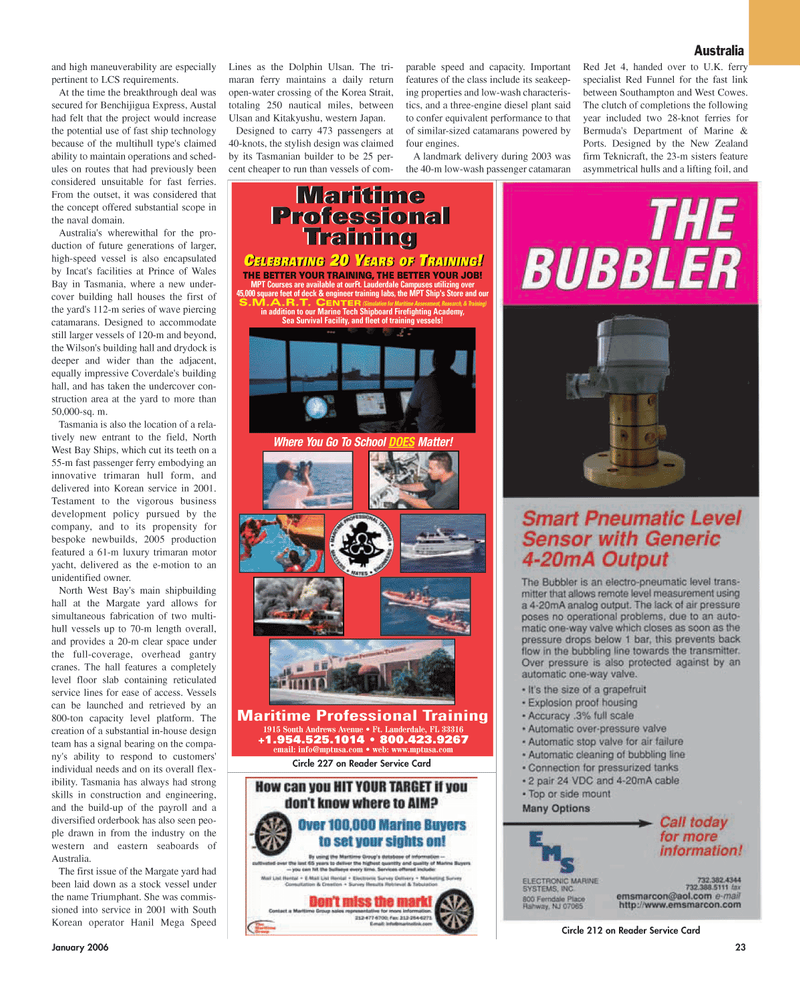
Page 23: of Maritime Reporter Magazine (January 2010)
Ship Repair & Conversion
Read this page in Pdf, Flash or Html5 edition of January 2010 Maritime Reporter Magazine
January 2006 23 and high maneuverability are especially pertinent to LCS requirements.
At the time the breakthrough deal was secured for Benchijigua Express, Austal had felt that the project would increase the potential use of fast ship technology because of the multihull type's claimed ability to maintain operations and sched- ules on routes that had previously been considered unsuitable for fast ferries.
From the outset, it was considered that the concept offered substantial scope in the naval domain.
Australia's wherewithal for the pro- duction of future generations of larger, high-speed vessel is also encapsulated by Incat's facilities at Prince of Wales
Bay in Tasmania, where a new under- cover building hall houses the first of the yard's 112-m series of wave piercing catamarans. Designed to accommodate still larger vessels of 120-m and beyond, the Wilson's building hall and drydock is deeper and wider than the adjacent, equally impressive Coverdale's building hall, and has taken the undercover con- struction area at the yard to more than 50,000-sq. m.
Tasmania is also the location of a rela- tively new entrant to the field, North
West Bay Ships, which cut its teeth on a 55-m fast passenger ferry embodying an innovative trimaran hull form, and delivered into Korean service in 2001.
Testament to the vigorous business development policy pursued by the company, and to its propensity for bespoke newbuilds, 2005 production featured a 61-m luxury trimaran motor yacht, delivered as the e-motion to an unidentified owner.
North West Bay's main shipbuilding hall at the Margate yard allows for simultaneous fabrication of two multi- hull vessels up to 70-m length overall, and provides a 20-m clear space under the full-coverage, overhead gantry cranes. The hall features a completely level floor slab containing reticulated service lines for ease of access. Vessels can be launched and retrieved by an 800-ton capacity level platform. The creation of a substantial in-house design team has a signal bearing on the compa- ny's ability to respond to customers' individual needs and on its overall flex- ibility. Tasmania has always had strong skills in construction and engineering, and the build-up of the payroll and a diversified orderbook has also seen peo- ple drawn in from the industry on the western and eastern seaboards of
Australia.
The first issue of the Margate yard had been laid down as a stock vessel under the name Triumphant. She was commis- sioned into service in 2001 with South
Korean operator Hanil Mega Speed
Lines as the Dolphin Ulsan. The tri- maran ferry maintains a daily return open-water crossing of the Korea Strait, totaling 250 nautical miles, between
Ulsan and Kitakyushu, western Japan.
Designed to carry 473 passengers at 40-knots, the stylish design was claimed by its Tasmanian builder to be 25 per- cent cheaper to run than vessels of com- parable speed and capacity. Important features of the class include its seakeep- ing properties and low-wash characteris- tics, and a three-engine diesel plant said to confer equivalent performance to that of similar-sized catamarans powered by four engines.
A landmark delivery during 2003 was the 40-m low-wash passenger catamaran
Red Jet 4, handed over to U.K. ferry specialist Red Funnel for the fast link between Southampton and West Cowes.
The clutch of completions the following year included two 28-knot ferries for
Bermuda's Department of Marine &
Ports. Designed by the New Zealand firm Teknicraft, the 23-m sisters feature asymmetrical hulls and a lifting foil, and
Circle 212 on Reader Service Card
Maritime
Professional
Training
Maritime Professional Training 1915 South Andrews Avenue • Ft. Lauderdale, FL 33316 +1.954.525.1014 • 800.423.9267 email: [email protected] • web: www.mptusa.com
Where You Go To School DOES Matter!
THE BETTER YOUR TRAINING, THE BETTER YOUR JOB!
MPT Courses are available at ourFt. Lauderdale Campuses utilizing over 45,000 square feet of deck & engineer training labs, the MPT Ship's Store and our
S.M.A.R.T. CENTER (Simulation for Maritime Assessment, Research, & Training) in addition to our Marine Tech Shipboard Firefighting Academy,
Sea Survival Facility, and fleet of training vessels!
CELEBRATING 20 YEARS OF TRAINING!
Australia
Circle 227 on Reader Service Card
MR JANUARY2006 #3 (17-24).qxd 1/5/2006 1:04 PM Page 23

 22
22

 24
24
